Microplastic in the Black Sea
Material, methods, samples
Material

- glass containers for collecting sand from the area of breaking waves, water and sand on the beach
- kits the analysis of physico-chemical factors
- Petri dishes, glass slides
- optical microscope (10X eyepiece, 10X lens, 20X, 40X, 18mm eyepiece lens diameter)
- stereomicroscope (10X eyepiece, objective, 2X, 4X,, eyepiece lens diameter 22 mm)
- metal sieves with a diameter of 2 mm, 0.5 μm, filter paper
- graduated cylinder, pipettes, Berzelius glasses
- tweezers, spatulate needle
Method for water samples

- 100 mL water samples are collected
- is filtered using a 0.2 mm filter
- is treated with 10% KOH solution and 30% H2O2 1:1
- keep the mixture for 24 hours
- isolate the microplastic from the supernatant
- Transfer to a Petri dish
- dry for 48 hours
- observe under a stereomicroscope (magnification power of 20X and 40X) and optical microscope (magnification power of 100X, 200X or 400X)
- take pictures
- fill in the observation sheets
Method for sediment samples

- samples of 100 g of sediment are collected (from the water line and on transect lines on the beach)
- transfer to 400 mL Berzelius beakers and treat with 28 Na NaCl solution to increase the density of the solution. Shake the solution
- isolate the microplastic from the supernatant treated with 15% HCl to destroy the remaining organic matter
- Transfer to a Petri dish
- dry for 48 hours
- observe under a stereomicroscope (magnification power of 20X and 40X) and optical microscope (magnification power of 100X, 200X or 400X)
- take pictures
- fill in the observation sheets
Method for bivalve samples
- 50 mussels (Mytilus galloprovincialis) are collected
- the digestive structures are dissected, isolated, mixed with a blender, then treated with 10% KOH solution and 30% H2O2 1:1 to remove organic matter
- the solution is filtered and transfered to a Petri dish
- dry for 48 hours
- observed under a stereomicroscope (magnification power of 2X and 4X) and optical microscope (magnification power of 100X, 200X or 400X)
- take pictures
- fill in the observation sheets